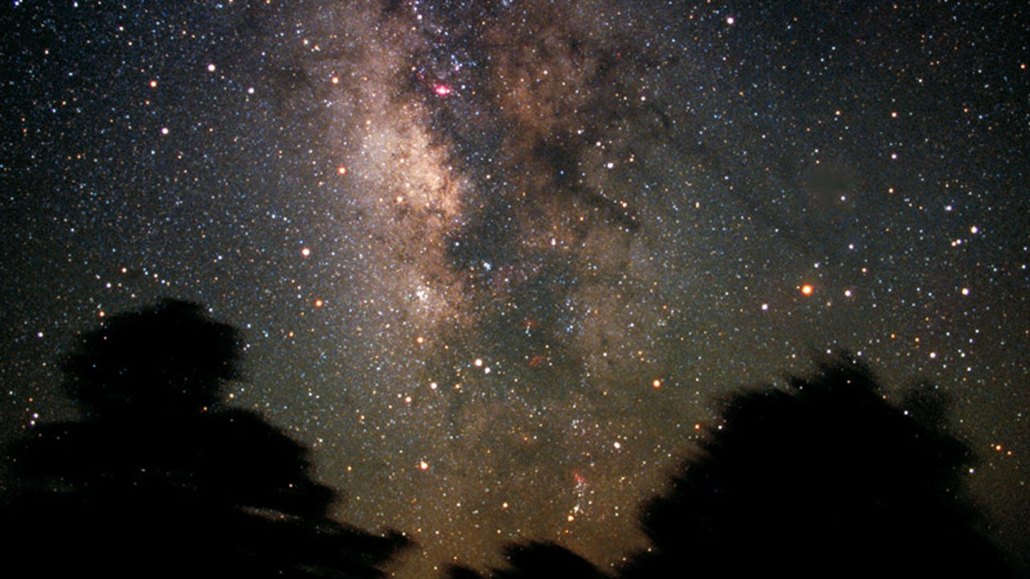
A population of millions of stars near the center of the Milky Way (shown) is the original seed from which the galaxy grew, researchers say. The eight-star "teapot" in the constellation Sagittarius can be seen on the left.
Terence Dickinson/ESA
The Milky Way left its “poor old heart” in and around the constellation Sagittarius, astronomers report. New data from the Gaia spacecraft reveal the full extent of what seems to be the galaxy’s original nucleus — the ancient stellar population that the rest of the Milky Way grew around — which came together more than 12.5 billion years ago.
“People have long speculated that such a vast population [of old stars] should exist in the center of our Milky Way, and Gaia now shows that there they are,” says astronomer Hans-Walter Rix of the Max Planck Institute for Astronomy in Heidelberg, Germany.
The Milky Way’s ancient heart is a round protogalaxy that spans nearly 18,000 light-years and possesses roughly 100 million times the mass of the sun in stars, or about 0.2 percent of the Milky Way’s current stellar mass, Rix and colleagues report in a study posted September 7 at arXiv.org.
“This study really helps to firm up our understanding of this very, very, very young stage in the Milky Way’s life,” says Vasily Belokurov, an astronomer at the University of Cambridge who was not involved in the work. “Not much is really known about this period of the Milky Way’s life,” he says. “We’ve seen glimpses of this population before,” but the new study gives “a bird’s-eye view of the whole structure.”
Most stars in the Milky Way’s central region abound with metals, because the stars originated in a crowded metropolis that earlier stellar generations had enriched with those metals through supernova explosions. But Rix and his colleagues wanted to find the exceptions to the rule, stars so metal-poor they must have been born well before the rest of the galaxy’s stellar denizens came along — what Rix calls “a needle-in-a-haystack exercise.”
His team turned to data from the Gaia spacecraft, which launched in 2013 on a mission to chart the Milky Way (SN: 6/13/22). The astronomers searched about 2 million stars within a broad region around the galaxy’s center, which lies in the constellation Sagittarius, looking for stars with metal-to-hydrogen ratios no more than 3 percent of the sun’s.
The astronomers then examined how those stars move through space, retaining only the ones that don’t dart off into the vast halo of metal-poor stars engulfing the Milky Way’s disk. The end result: a sample of 18,000 ancient stars that represents the kernel around which the entire galaxy blossomed, the researchers say. By accounting for stars obscured by dust, Rix estimates that the protogalaxy is between 50 million and 200 million times as massive as the sun.
“That’s the original core,” Rix says, and it harbors the Milky Way’s oldest stars, which he says probably have ages exceeding 12.5 billion years. The protogalaxy formed when several large clumps of stars and gas conglomerated long ago, before the Milky Way’s first disk — the so-called thick disk — arose (SN: 3/23/22).
The protogalaxy is compact, which means little has disturbed it since its formation. Smaller galaxies have crashed into the Milky Way, augmenting its mass, but “we didn’t have any later mergers that deeply penetrated into the core and shook it up, because then the core would be larger now,” Rix says.
The new data on the protogalaxy even capture the Milky Way’s initial spin-up — its transition from an object that didn’t rotate into one that now does. The oldest stars in the proto–Milky Way barely revolve around the galaxy’s center but dive in and out of it instead, whereas slightly younger stars show more and more movement around the galactic center. “This is the Milky Way trying to become a disk galaxy,” says Belokurov, who saw the same spin-up in research that he and a colleague reported in July.
Today, the Milky Way is a giant galaxy that spins rapidly — each hour our solar system speeds through 900,000 kilometers of space as we race around the galaxy’s center. But the new study shows that the Milky Way got its start as a modest protogalaxy whose stars still shine today, stars that astronomers can now scrutinize for further clues to the galaxy’s birth and early evolution.







